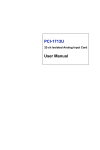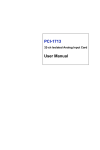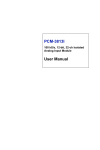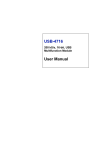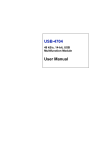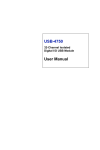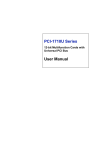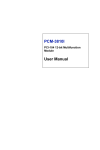Download Advantech PCI-1715U User manual
Transcript
PCI-1715U 32-ch Isolated Analog Input Card User Manual Copyright The documentation and the software included with this product are copyrighted 2007 by Advantech Co., Ltd. All rights are reserved. Advantech Co., Ltd. reserves the right to make improvements in the products described in this manual at any time without notice. No part of this manual may be reproduced, copied, translated or transmitted in any form or by any means without the prior written permission of Advantech Co., Ltd. Information provided in this manual is intended to be accurate and reliable. However, Advantech Co., Ltd. assumes no responsibility for its use, nor for any infringements of the rights of third parties, which may result from its use. Acknowledgements Intel and Pentium are trademarks of Intel Corporation. Microsoft Windows and MS-DOS are registered trademarks of Microsoft Corp. All other product names or trademarks are properties of their respective owners. Printed in Taiwan PCI-1715U User Manual April 2007 ii 1st Edition Product Warranty (2 years) Advantech warrants to you, the original purchaser, that each of its products will be free from defects in materials and workmanship for two years from the date of purchase. This warranty does not apply to any products which have been repaired or altered by persons other than repair personnel authorized by Advantech, or which have been subject to misuse, abuse, accident or improper installation. Advantech assumes no liability under the terms of this warranty as a consequence of such events. Because of Advantech’s high quality-control standards and rigorous testing, most of our customers never need to use our repair service. If an Advantech product is defective, it will be repaired or replaced at no charge during the warranty period. For out-of-warranty repairs, you will be billed according to the cost of replacement materials, service time and freight. Please consult your dealer for more details. If you think you have a defective product, follow these steps: 1. Collect all the information about the problem encountered. (For example, CPU speed, Advantech products used, other hardware and software used, etc.) Note anything abnormal and list any onscreen messages you get when the problem occurs. 2. Call your dealer and describe the problem. Please have your manual, product, and any helpful information readily available. 3. If your product is diagnosed as defective, obtain an RMA (return merchandize authorization) number from your dealer. This allows us to process your return more quickly. 4. Carefully pack the defective product, a fully-completed Repair and Replacement Order Card and a photocopy proof of purchase date (such as your sales receipt) in a shippable container. A product returned without proof of the purchase date is not eligible for warranty service. 5. Write the RMA number visibly on the outside of the package and ship it prepaid to your dealer. iii Declaration of Conformity CE This product has passed the CE test for environmental specifications when shielded cables are used for external wiring. We recommend the use of shielded cables. This kind of cable is available from Advantech. Please contact your local supplier for ordering information. Technical Support and Assistance Step 1. Visit the Advantech web site at www.advantech.com/support where you can find the latest information about the product. Step 2. Contact your distributor, sales representative, or Advantech's customer service center for technical support if you need additional assistance. Please have the following information ready before you call: - Product name and serial number - Description of your peripheral attachments - Description of your software (operating system, version, application software, etc.) - A complete description of the problem - The exact wording of any error messages Safety Instructions 1. Read these safety instructions carefully. 2. Keep this User's Manual for later reference. 3. Disconnect this equipment from any AC outlet before cleaning. Use a damp cloth. Do not use liquid or spray detergents for cleaning. 4. For plug-in equipment, the power outlet socket must be located near the equipment and must be easily accessible. 5. Keep this equipment away from humidity. 6. Put this equipment on a reliable surface during installation. Dropping it or letting it fall may cause damage. 7. The openings on the enclosure are for air convection. Protect the equipment from overheating. DO NOT COVER THE OPENINGS. 8. Make sure the voltage of the power source is correct before connecting the equipment to the power outlet. PCI-1715U User Manual iv 9. Position the power cord so that people cannot step on it. Do not place anything over the power cord. 10. All cautions and warnings on the equipment should be noted. 11. If the equipment is not used for a long time, disconnect it from the power source to avoid damage by transient overvoltage. 12. Never pour any liquid into an opening. This may cause fire or electrical shock. 13. Never open the equipment. For safety reasons, the equipment should be opened only by qualified service personnel. 14. If one of the following situations arises, get the equipment checked by service personnel: a. The power cord or plug is damaged. b. Liquid has penetrated into the equipment. c. The equipment has been exposed to moisture. d. The equipment does not work well, or you cannot get it to work according to the user's manual. e. The equipment has been dropped and damaged. f. The equipment has obvious signs of breakage. 15. DO NOT LEAVE THIS EQUIPMENT IN AN ENVIRONMENT WHERE THE STORAGE TEMPERATURE MAY GO BELOW 20° C (-4° F) OR ABOVE 60° C (140° F). THIS COULD DAMAGE THE EQUIPMENT. THE EQUIPMENT SHOULD BE IN A CONTROLLED ENVIRONMENT. 16. CAUTION: DANGER OF EXPLOSION IF BATTERY IS INCORRECTLY REPLACED. REPLACE ONLY WITH THE SAME OR EQUIVALENT TYPE RECOMMENDED BY THE MANUFACTURER, DISCARD USED BATTERIES ACCORDING TO THE MANUFACTURER'S INSTRUCTIONS. The sound pressure level at the operator's position according to IEC 7041:1982 is no more than 70 dB (A). DISCLAIMER: This set of instructions is given according to IEC 704-1. Advantech disclaims all responsibility for the accuracy of any statements contained herein. v Safety Precaution - Static Electricity Follow these simple precautions to protect yourself from harm and the products from damage. 1. To avoid electrical shock, always disconnect the power from your PC chassis before you work on it. Don't touch any components on the CPU card or other cards while the PC is on. 2. Disconnect power before making any configuration changes. The sudden rush of power as you connect a jumper or install a card may damage sensitive electronic components. PCI-1715U User Manual vi Contents Chapter 1 Overview .......................................................... 2 1.1 1.2 1.3 Chapter 2 Installation ....................................................... 4 2.1 2.2 2.3 Chapter Chapter Introduction ....................................................................... 2 Features ............................................................................. 2 Software Overview............................................................ 2 Unpacking ......................................................................... 4 Driver Installation ............................................................. 5 Installation Instructions ..................................................... 6 3 Signal Connections .......................................... 8 3.1 3.2 Overview ........................................................................... 8 I/O Connector ................................................................... 8 3.3 Analog Input Connections................................................. 9 3.4 Field Wiring Considerations ........................................... 12 Figure 3.1:I/O Connector Pin Assignments ................... 8 Table 3.1:I/O Connector Signal Description ................. 9 Figure 3.2:Single Ended Input Channel Connection ..... 9 Figure 3.3:Differential Input-Grounded Signal Source 10 4 Calibration ..................................................... 14 4.1 4.2 Introduction ..................................................................... 14 VR Assignment ............................................................... 14 4.3 A/D Calibration ............................................................... 15 Figure 4.1:PCL-1715U VR Assignments .................... 14 Appendix A Specifications ................................................. 18 A.1 A.2 Analog Input.................................................................... 18 General ............................................................................ 19 vii Table of Contents PCI-1715U User Manual viii CHAPTER 1 2 Overview Chapter 1 Overview 1.1 Introduction The PCI-1715U is a 12-bit 32-channel analog input card for the PCI bus. It provides 32 analog input channels with a sampling rate up to 500k samples/s, 12-bit resolution and isolation protection of 2500 VDC. 1.2 Features • 32 single-ended or 16 differential analog inputs, or a combination • 12-bit A/D converter, with up to 500 kHz sampling rate • Programmable gain for each input channel • Automatic channel/gain scanning • Onboard 1024 samples FIFO buffer • Programmable pacer • BoardID • PCI Bus-master data transfer 1.3 Software Overview Advantech offers a rich set of DLL drivers, 3rd -party driver support and application software to help exploit the functions of your device. Advantech’s Device Drivers feature an I/O function library to help boost your application performance and works seamlessly with development tools such as Visual C++, VB, Inprise C++ Builder, and Inprise Delphi. Please refer to the corresponding sections in these chapters on the Device Drivers Manual to begin your programming. You can also look at the example source code provided for each programming tool. The Device Drivers Manual can be found on the companion CD-ROM. Alternatively, if you have already installed the Device Drivers, the Device Drivers Manual can be accessed through the Start button: Start/Programs/Advantech Automation/Advantech Device Manager / Device Driver’s Manual The example source code can be found under the corresponding folder: \Program Files\Advantech\ADSAPI\Examples PCI-1715U User Manual 2 CHAPTER 2 2 Installation Chapter 2 Installation 2.1 Unpacking After receiving your PCI-1715U package, please inspect its contents first. The package should contain the following items: • PCI-1715U Card • Companion CD-ROM (DLL driver included) • User Manual The PCI-1715U card harbors certain electronic components vulnerable to electrostatic discharge (ESD). ESD could easily damage the integrated circuits and certain components if preventive measures are not carefully paid attention to. Before removing the card from the antistatic plastic bag, you should take following precautions to ward off possible ESD damage: • Touch the metal part of your computer chassis with your hand to discharge static electricity accumulated on your body. Or one can also use a grounding strap. • Touch the antistatic bag to a metal part of your computer chassis before opening the bag. • Take hold of the card only by the metal bracket when removing it out of the bag. After taking out the card, you should first: • Inspect the card for any possible signs of external damage (loose or damaged components, etc.). If the card is visibly damaged, please notify our service department or the local sales representative immediately. Avoid installing a damaged card into your system. Also pay extra caution to the following to ensure proper installation: • Avoid physical contact with materials that could hold static electricity such as plastic, vinyl and Styrofoam. • Whenever you handle the card, grasp it only by its edges. DO NOT TOUCH the exposed metal pins of the connector or the electronic components. PCI-1715U User Manual 4 2.2 Driver Installation We recommend you install the software driver before installing the PCI1715U module, since this will guarantee a smooth installation process. The 32-bit DLL driver Setup program for the PCI-1715U module is included on the companion CD-ROM that is shipped with your module package. Please follow the steps on the following page to install the driver software: For further information on driver-related issues, an online version of the Device Drivers Manual is available by accessing the following path: Start\Programs\Advantech Automation \Device Manager\Device Driver’s Manual 5 Chapter 2 2.3 Installation Instructions The PCI-1715U can be installed in any PCI slot in the computer. However, refer to the computer user's manual to avoid any mistakes and danger before you follow the installation procedure below: 1. Turn off your computer and any accessories connected to the computer. Warning!TURN OFF your computer power supply whenever you install or remove any card, or connect and disconnect cables. 2. Disconnect the power cord and any other cables from the back of the computer. 3. Remove the cover of the computer. 4. Select an empty +5 V PCI slot. Remove the screw that secures the expansion slot cover to the system unit. Save the screw to secure the interface card retaining bracket. 5. Carefully grasp the upper edge of the PCI-1715U. Align the hole in the retaining bracket with the hole on the expansion slot and align the gold striped edge connector with the expansion slot socket. Press the card into the socket gently but firmly. Make sure the card fits the slot tightly. 6. Secure the PCI-1715U by screwing the mounting bracket to the back panel of the computer. 7. Attach any accessories (37-pin D-type cable) to the card. 8. Replace the cover of your computer and connect the cables you removed in step 2. 9. Turn the computer power on. PCI-1715U User Manual 6 3 CHAPTER 2 Signal Connections Chapter 3 Signal Connections 3.1 Overview Correct signal connections are one of the most important factors in ensuring that your application system is sending and receiving data correctly. A good signal connection can avoid much unnecessary and costly damage to your valuable PC and other hardware devices. This chapter will provide some useful information about how to connect analog input signals to the PCI-1715U card via the I/O connector. 3.2 I/O Connector The I/O connector for the PCI-1715U card is a 37-pin D-type connector which you can connect to 37-pin D-type accessories with Advantech's PCL-10137 cable. Note: The PCI-1715U does not include the PCL-10137 cable assembly. The following figure shows the pin assignments for the 37-pin I/O connector on the PCI-1715U card. Figure 3.1: I/O Connector Pin Assignments PCI-1715U User Manual 8 Table 3.1: I/O Connector Signal Description Signal Name Reference Direction Description AI<0…31> GND Input Analog Input Channels 0 through 31. GND - - Ground EXT_TRG GND Input A/D External Trigger. 3.3 Analog Input Connections This section continues to describe how to make analog input signal connections to the PCI-1715U card via the I/O connector. Single-ended Channel Connections The single-ended input configuration has only one signal wire for each channel, and the measured voltage (Vm) is the voltage of the wire referred to the common ground. A signal source without a local ground is also called a “floating source”. It is fairly simple to connect a single-ended channel to a floating signal source. In this mode, the PCI-1715U card provides a reference ground for external floating signal sources. Figure 3-2 shows a single-ended channel connection between a floating signal source and an input channel on the PCI-1715U card. Internal External AI0 AI1 + Multiplexers AI31 + + Vs _ Floating Signal Source PGIA _ Measured Vm Voltage GND _ I/O Connector Figure 3.2: Single Ended Input Channel Connection 9 Chapter 3 Differential Channel Connections The differential input configuration has two signal wires for each channel, and each input responds only to voltage differences between High and Low inputs. On the PCI-1715U card, when all channels are configured to differential input, up to 16 analog channels are available. If one side of the signal source is connected to a local ground, the signal source is ground-referenced. The ground of the signal and the ground of the PCI-1715U will not be the same voltage, as they are connected through the ground return of the equipment and building wiring. The difference between the voltages forms a common-mode voltage (Vcm). To avoid the ground loop noise effect caused by common-mode voltages, you can connect the signal ground to the Low input. Figure 3-3 shows a differential channel connection between a ground-referenced signal source and an input channel on the PCI-1715U card. With this connection, the PGIA rejects a common-mode voltage Vcm between the signal source and the PCI-1715U ground, shown as Vcm in Figure 3-3. If a floating signal source is connected to the differential input channel, the signal source may exceed the common-mode signal range of the PGIA, and the PGIA will be saturated with erroneous voltage-readings. You must therefore reference the signal source to the AIGND. Figure 3-4 shows a differential channel connection between a floating signal source and an input channel on the PCI-1715U card. In this figure, each side of the floating signal source is connected through a resistor to the AIGND. This connection can reject the common-mode voltage between the signal source and the PCI-1715U card ground. Internal External AI0 AI2 Multiplexer + PGIA Measured Voltage GroundReferenced Signal Source AI30 AI1 _ AI3 Multiplexer AI31 GND I/O Connector Figure 3.3: Differential Input-Grounded Signal Source PCI-1715U User Manual 10 External Trigger Source Connection In addition to pacer triggering, the PCI-1715U card also allows external triggering for A/D conversions. A low-to-high edge coming from EXT_TRG will trigger an A/D conversion on the PCI-1715U board. Note: Please ascertain that turn on your external trigger source and connect it to "EXT_TRG" BEFORE acquire analog input signals. Note: Don't connect any signal to the EXT_TRG pin when the external trigger function is not being used. Note: If you use external triggering for A/D conversions, we recommend you choose differential mode for all analog input signals, so as to reduce the cross-talk noise caused by the external trigger source. Note: Charge Injection Error A small electric charge will be produced every time when a multiplexed data-acquisition device switched channels, and consequently creates a small voltage drop across that output impedance, which makes the measured voltage different than its actual value, namely the charge injection error. To minimize the charge injection errors, a signal source/ sensor with the low impendence is recommended, or using a op amplifier connecting to the signal source can also effectively lower the charge injection errors. 11 Chapter 3 3.4 Field Wiring Considerations When you use the PCI-1715U card to acquire outside data, environmental noise can seriously affect the accuracy of your measurements if you don’t provide any protection. The following suggestions will be helpful when running signal wires between signal sources and the PCI-1715U card. • Please make sure that you have carefully routed signal cables to the card. You must separate the cabling from noise sources. Try to keep video monitors far away from the analog signal cables, because these are a common noise source in a PCI data acquisition system. • If you want to reduce common-mode noise, try to use differential analog input connections. • If you do not want your signals to be affected when travelling through areas with high electromagnetic interference or large magnetic fields, try the following routing techniques: Use individually shielded, twisted-pair wires to connect analog input signals to the board, i.e. the signals connected to the High and Low inputs aretwisted together and covered with a shield. Finally, connect the shield only to one point at the signal source ground. • Make sure that your signal lines do not travel through conduits, because these may contain power lines. Also, keep your signals far from electric motors, breakers or welding equipment, as these can create magnetic fields. • Keep a reasonable distance between high-voltage (or high-current) lines and signal cables connected to the PCI-1715U card if the cables run parallel, or route signal cables at right angles to high voltage/current cables. PCI-1715U User Manual 12 CHAPTER 4 2 Calibration Chapter 4 Calibration 4.1 Introduction Regular calibration checks are important to maintain accuracy in data acquisition and control applications. To assist users in the A/D calibration process, we provide one calibration program, ADCAL.EXE, on the PCI-1715U software CD-ROM. The ADCAL.EXE program makes A/D calibrations easy. It leads you through the calibration and setup procedure with a variety of prompts and graphic displays, showing you all of the correct settings and adjustments. This chapter offers a brief guide to these calibration programs. To perform a satisfactory calibration, you need a 41/2-digit digital multimeter and a voltage calibrator or a stable, noise free D. C. voltage source. 4.2 VR Assignment There are four variable resistors (VRs) on the PCL-1715U card. They help you to make accurate adjustments on all A/D channels. Please refer to the following figure for VR positions. Figure 4.1: PCL-1715U VR Assignments PCI-1715U User Manual 14 The following list shows the function of each VR: VR Function VR1 A/D full scale (gain) VR2 A/D bipolar offset VR3 A/D unipolar offset VR4 PGIA initial offset TP1 PGIA output 4.3 A/D Calibration Regular and accurate calibration procedures ensure the maximum possible accuracy. The ADCAL.EXE calibration program leads you through the whole A/D offset and gain adjustment procedure. The basic steps are outlined below: 1. Set analog input channel AI0 as single-ended, bipolar, range ±5 V and connect to the ground. 2. Read TP1 as VG1. 3. Change AI0 range to ±0.625 V and read TP1 as VG8. 4. Adjust VR4 until -0.05 mV < VG1 - VG8 < 0.05 mV. 5. Repeat steps 1 ~ 4 until ther is no more need to adjust VR4. 6. Set analog input channel AI0 as single-ended, bipolar, range ±5 V, and set AI1 as single-ended, unipolar, range 0 to 10 V. 7. Connect a DC voltage source with value equal to 0.5 LSB (-4.9959 V) to AI0. 8. Adjust VR2 until the output codes from the card's AI0 flickers between 0 and 1. 9. Connect a DC voltage source with a value of 4094.5 LSB (4.9953 V) to AI0. 10. Adjust VR1 until the output codes from the card's AI0 flickers between 4094 and 4095. 11. Repeat step 7 to step 10, adjusting VR2 and VR1. 12. Connect a DC voltage source with value equal to 2047.5 LSB (4.9959 V) to AI1. 13. Adjust VR3 until the output codes from the card's AI1 flickers between 2047 and 2048. 15 Chapter 4 A/D Code Mapping Voltage Hex. Dec. Bipolar ± 5V Unipolar 0 to 10V 000h 0 -4.9971V 0V 7FFh 2047 -0.0024V 4.9947V 800h 2048 0V 4.9971V FFFh 4095 +4.9947V 9.9918V PCI-1715U User Manual 16 APPENDIX A 2 Specifications Appendix A Specifications A.1 Analog Input Channels 32 single-ended or 16 differential or combination Resolution 12-bit FIFO Size 1K samples Sampling Rate 500 KS/s Input range and Gain List Gain 0.5 1 2 4 8 Unipolar N/A 0~10 0~5 0~2.5 0~1.25 Drift Small Signal Bandwidth for PGA Common Mode Voltage Bipolar ±10 ±5 ±2.5 ±1.25 ±0.625 Gain 0.5 1 2 4 8 Zero (µV/°C) Gain (ppm/°C) Gain 40 40 40 20 15 8 8 7 5 5 0.5 1 2 4 8 Bandwidth 500kHz ±9V max. (operational) Max. Input Voltage ±15 V Input Protect 30 Vp-p Input Impedance 1G Trigger Mode Software, onboard Programmable Pacer or External Accuracy DC INLE: ±1 LSB Monotonicity: 12 bits Offset error: Adjustable to zero Gain 0.5 Gain error 0.06 (% FSR) Ch Type AC 18 2 4 8 0.03 0.05 0.07 0.09 S.E./D S.E./D S.E./D D SNR: 68 dB ENOB: 11 bits PCI-1715U User Manual 1 D A.2 General I/O Connector Type DSub-37 female Dimensions 175 × 100 mm (6.9" × 3.9") Power Consumption Typical +5 V @ 500 mA Max. +5 V @ 700 mA Temperature Operation 0~+60°C (32~158°F) (refer to IEC 68-2-1,2) Relative Humidity Storage -20~+85°C (-4~185°F) 5~95%RH non-condensing (refer to IEC 68-2-3) Certification CE certified 19 Appendix A PCI-1715U User Manual 20




























